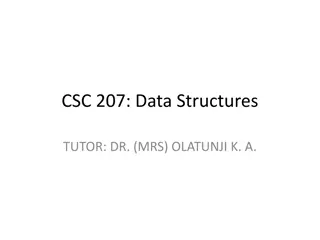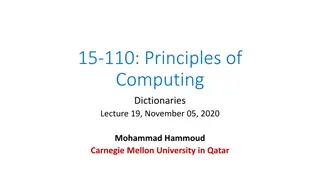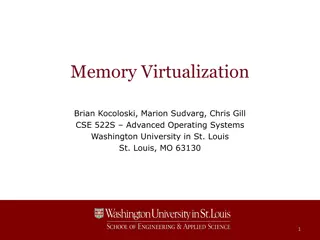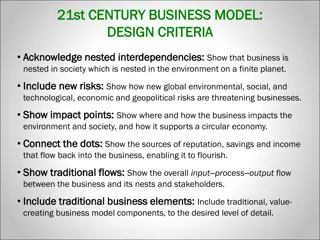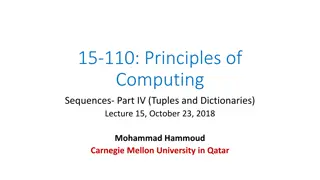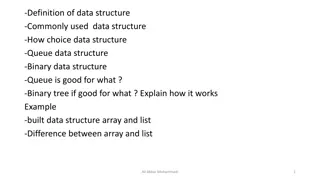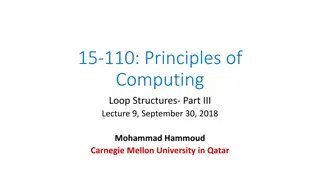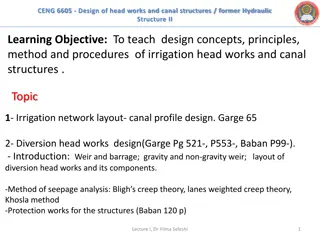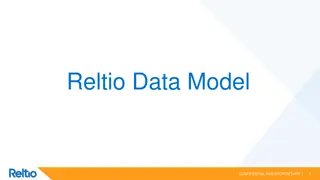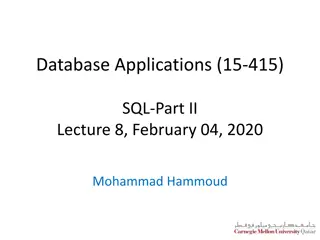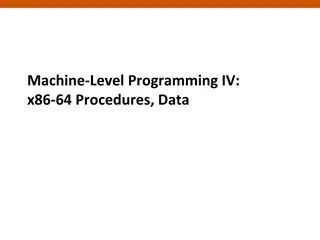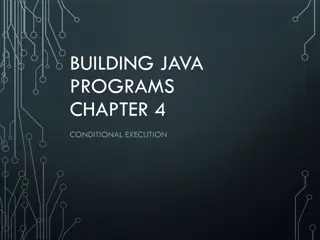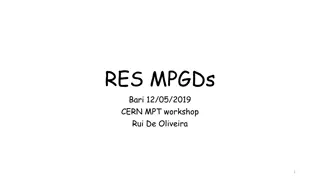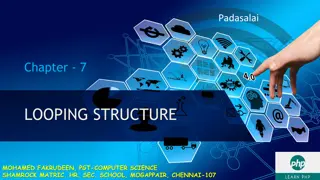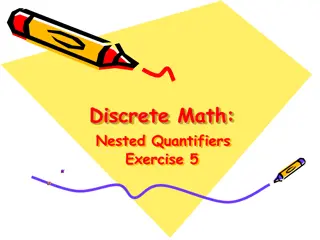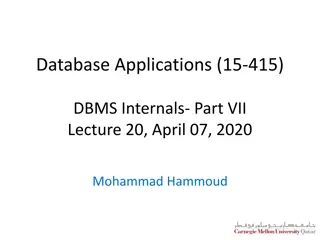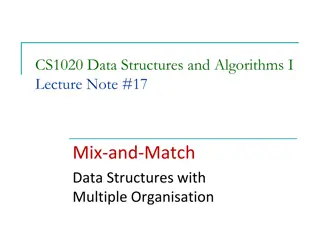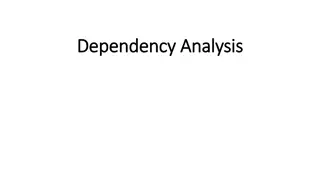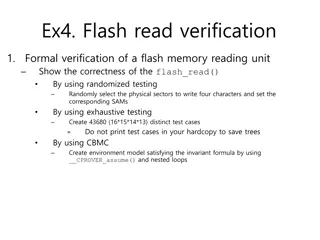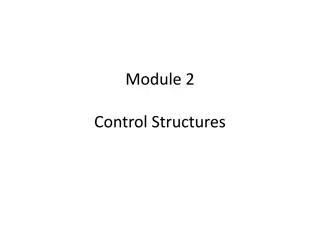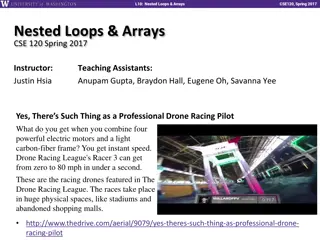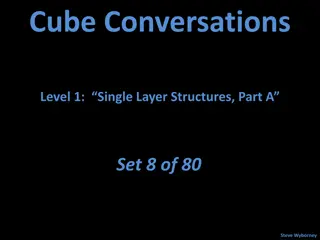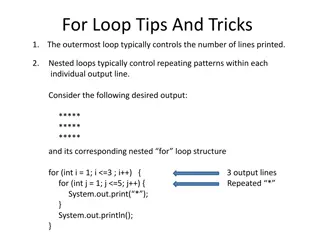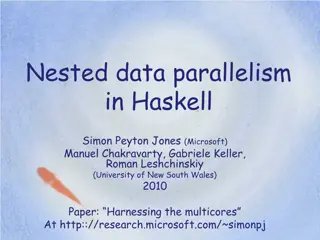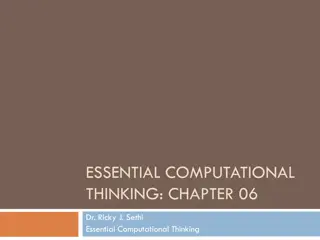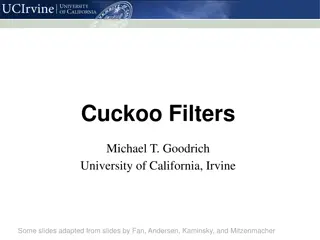Comparing Logit and Probit Coefficients between Models
Richard Williams, with assistance from Cheng Wang, discusses the comparison of logit and probit coefficients in regression models. The essence of estimating models with continuous independent variables is explored, emphasizing the impact of adding explanatory variables on explained and residual vari
1 views • 43 slides
Effective Coordinating Structures for Response Operations
Operational coordination involves actions and activities to enable decision-makers to determine appropriate courses of action for various incidents, including homeland security operations. Coordinating structures help organize response efforts to address mission requirements, improve access to resou
3 views • 19 slides
Understanding Data Structures in CSC 207 with Dr. Olatunji K. A.
This course covers the objectives, learning outcomes, and contents related to data structures in CSC 207. Students will learn about data type specifications, representation techniques, algorithm analysis, recursive methods, and practical applications of data structures. The course delves into basic
1 views • 22 slides
Understanding Dictionaries in Python
Dictionaries in Python allow storing elements with keys of various hashable types and values of any data type. Keys must be unique, but values can be duplicated. Dictionaries cannot be concatenated but can be nested. When passed to a function, dictionaries exhibit pass-by-reference behavior due to t
2 views • 14 slides
Understanding Memory Virtualization in Operating Systems
Memory virtualization in operating systems involves mapping guest addresses to host addresses with an added level of indirection managed by the hypervisor. Virtualization extensions in x86 processors enhance efficiency by allowing safe execution of guest code in Ring 0 through supervisor mode. The a
1 views • 28 slides
Understanding Control Structures in Programming
Control structures in programming allow programmers to manage the flow of execution with selection/decision and repetition/loop structures. This chapter explores different types of selection control structures like if, if-else, nested if-else, and switch-case statements, providing examples and exerc
2 views • 30 slides
Evolving Business Models in the 21st Century: Embracing Interdependencies
Business models in the 21st century are evolving to acknowledge nested interdependencies with society and the environment on a finite planet. New global risks and impact points are challenging businesses, highlighting the need for a shift towards a circular economy. The traditional business model co
2 views • 7 slides
Understanding Tuples and Dictionaries in Computing Sequences
Tuples are immutable data structures similar to lists, written with round brackets. They can contain different types of elements, be sliced and indexed similarly to lists, concatenated, repeated, nested, and passed by value to functions. Examples show how tuples operate and differentiate from lists.
1 views • 21 slides
Exploring Trees Data Structures Using C - Second Edition
Learn about trees data structures in the context of programming using the C language. This comprehensive guide covers topics such as types of trees, tree creation, traversal, basic terminologies, and different tree structures like binary trees and binary search trees. Dive into the world of trees da
1 views • 54 slides
Transforming SNOMED CT Translation with Nested Concepts and Expression Templates
Adopting nested concepts and expression templates revolutionizes SNOMED CT translation, offering a more structured approach that streamlines the process from selection to standardization, enhancing accuracy and efficiency significantly.
0 views • 25 slides
Understanding Data Structures: A Comprehensive Overview
Data structures are schemes for organizing data in a computer's memory, influencing program performance. Common structures like queues and binary trees are outlined, illustrating their organization and use cases. The choice of data structures impacts task efficiency, with programmers analyzing data
0 views • 20 slides
Understanding Loop Structures in Python Programming
This lecture covers Loop Structures, specifically focusing on the while statement and nested loops in Python programming. It discusses the Fibonacci sequence and demonstrates how to write a program to compute the nth Fibonacci number. Additionally, it explains the difference between definite and ind
3 views • 22 slides
Design of Head Works and Canal Structures - Learning Objectives and Evaluation
This course covers the design concepts, principles, methods, and procedures related to the design of irrigation head works and canal structures. Topics include irrigation network layout, diversion head works design, seepage analysis methods, protection works, canal profile design, canal head regulat
0 views • 4 slides
SQL Query Examples and Operators
This comprehensive guide provides examples of SQL queries utilizing various operators such as the BETWEEN comparison operator, aggregate functions, having clause, nested subqueries, and set membership. It covers practical examples including finding instructors within a salary range, counting custome
1 views • 13 slides
Understanding Reltio Data Model and Architecture
Reltio offers a dynamic and metadata-driven data model that simplifies database modeling and allows for easy changes without impacting the underlying storage. Key differences between Reltio and relational models include multi-valued attributes, nested attributes, and built-in address cleanse engine.
2 views • 18 slides
Understanding Dictionaries in Python
Dictionaries in Python allow you to store elements with keys of any type and values of any type. They can contain any and different types of elements, have unique keys but can have duplicate values, cannot be concatenated or repeated, can be nested, and are mutable like lists. Dictionaries can be it
0 views • 13 slides
Exploring SQL Queries and Joins in Database Applications Lecture
Discover a comprehensive overview of SQL queries, including nested and deeply nested queries, in the context of database applications. Learn about joining tables, finding sailors who reserved specific boats, handling NULL values, and more in this informative lecture featuring examples and explanatio
0 views • 53 slides
Understanding x86-64 Procedures and Data Structures
This content provides insights into x86-64 programming, covering topics such as procedures, integer registers, stack frames, locals in the red zone, interesting features of stack frames, arrays, multi-dimensional structures, and more. It dives into the usage conventions of integer registers, the all
0 views • 44 slides
SQL Part II Lecture Summary: Nested Queries, Joins, and Updates for Database Applications
In this SQL lecture, Mohammad Hammoud covers nested queries, insertion, deletion, updates, handling NULL values, join variants, and advanced query techniques. Examples include finding sailors who have reserved specific boats, using nested queries to filter data, and deep nested queries for complex d
0 views • 53 slides
Understanding Conditional Execution in Java Programming
Explore the concept of conditional execution in Java programming with if/else statements, relational expressions, and misuse examples. Discover nested if/else structures and their application in decision-making logic. Enhance your understanding of executing code based on specific conditions.
0 views • 24 slides
Understanding Conditional Execution in Programming
Conditional execution, such as the if statement, allows executing specific blocks of code based on certain conditions being met. This concept is fundamental in programming and is demonstrated through examples like if, if/else, relational expressions, and nested if/else constructs. The incorrect usag
2 views • 44 slides
Innovative Resistive Layers and Structures for Particle Detection at CERN
Explore the latest advancements in resistive layers and structures designed for particle detection at CERN. The research covers various types of resistive structures, including GEM and BULK Micromegas, and delves into topics such as spark protection, energy levels, and material vaporization. Detaile
0 views • 39 slides
Understanding Looping Structures in PHP
Looping structures are essential in programming for writing iteration logics. This article delves into the importance of looping structures, different types in PHP, and creating basic logic using loops like for, while, for each, and do-while. Learn the syntax, parameters, examples, and flow charts t
0 views • 23 slides
Nested Quantifiers Exercise on Love Statements
This exercise involves utilizing nested quantifiers to express various statements related to love between individuals in a world domain. Statements cover scenarios such as everyone loving a particular person, someone not being loved by everyone, self-love, and unique loving relationships. The soluti
1 views • 6 slides
Understanding Join Algorithms in Database Systems
This presentation delves into the intricacies of join algorithms in DBMS, focusing on various techniques such as simple nested loops join, block nested loops join, index nested loops join, sort-merge join, and hash join. The importance of optimizing joins to avoid unnecessary cross-products is empha
0 views • 67 slides
Mix and Match Data Structures for Efficient Algorithms
Discover how to combine basic data structures like arrays, linked lists, and trees to create specialized data structures for various applications. Explore the concept of mix-and-match data structures with multiple organizations to implement efficient algorithms like adjacency lists and matrices for
0 views • 12 slides
Understanding Cross-Classified Models in Multilevel Modelling
Cross-classified models in multilevel modelling involve non-hierarchical data structures where entities are classified within multiple categories. These models extend traditional nested multilevel models by accounting for complex relationships among data levels. Professor William Browne from the Uni
0 views • 13 slides
Understanding Data Dependencies in Nested Loops
Studying data dependencies in nested loops is crucial for optimizing code performance. The analysis involves assessing dependencies across loop iterations, iteration numbers, iteration vectors, and loop nests. Dependencies in loop nests are determined by iteration vectors, memory accesses, and write
0 views • 15 slides
Formal Verification of Flash Memory Reading Unit
Perform formal verification of a flash memory reading unit by demonstrating correctness using randomized testing and exhaustive testing. Randomly select physical sectors to write characters and set corresponding Security Assertion Markup (SAM) structures. Create a total of 43,680 distinct test cases
0 views • 5 slides
Understanding Perl Control Structures and Comparison Operators
In Perl, comparison operators are used for standard comparisons, where Perl supports operators like greater than (>), less than (<), greater than or equal to (>=), less than or equal to (<=), equal to (==), and not equal to (!=). Boolean values like true and false are represented by numerical values
0 views • 25 slides
Understanding Nested Loops and Arrays in CSE120, Spring 2017
Dive into the world of nested loops and arrays in CSE120 during the Spring semester of 2017. Explore the fascinating concepts of nested loops, for-loop reviews, and arrays through examples and student work showcases. Discover how these fundamental programming elements can be utilized to control sequ
0 views • 22 slides
Performance Analysis of Synchronization Methods in Concurrent Data Structures
Explore the impact of synchronization methods on the performance and behavior of concurrent data structures in multithreaded applications. The study involves developing and implementing concurrent data structures, analyzing coarse-grain locking, fine-grain locking, lock-free mechanisms, and assessin
0 views • 25 slides
Understanding Structures and Unions in C Programming
Exploring the concept of structures and unions in the C programming language, this reference material covers their definition, initialization, assignment, members, arrays, and nested structures. Learn how structures aggregate data types and how unions can share memory locations. Gain insights into s
0 views • 20 slides
Exploring Single Layer Structures with Cube Conversations
Dive into the exploration of single-layer structures with Cube Conversations. Discover different perspectives on visualizing these structures and uncover various ways to analyze and think about them. Engage in critical thinking and problem-solving to understand the composition of unit cubes in the g
0 views • 5 slides
Mastering Nested For Loops: Tips and Tricks for Efficient Code Structure
Explore strategies for utilizing nested for loops effectively in your programming tasks. Learn how to control the number of lines printed, manage repeating patterns, and adjust output length using incrementing and decrementing outer loops. Enhance your coding skills with examples and best practices
0 views • 10 slides
Overview of Nested Data Parallelism in Haskell
The paper by Simon Peyton Jones, Manuel Chakravarty, Gabriele Keller, and Roman Leshchinskiy explores nested data parallelism in Haskell, focusing on harnessing multicore processors. It discusses the challenges of parallel programming, comparing sequential and parallel computational fabrics. The evo
0 views • 55 slides
Resonance Phenomena in Grating Structures and Applications
Resonance phenomena in grating structures, such as dielectric or metal gratings on substrates, offer sensitive elements for detecting biological and chemical agents. The sensitivity of these structures is described by equations relating to resonant wavelength changes and the refractive index of inve
0 views • 20 slides
Development of Fetal Head and Neck Structures in Week 12
The fetal head and neck structures in week 12 exhibit a complex formation process involving contributions from all three embryonic layers and the neural crest. Neural crest plays a significant role in developing jaw skeletal elements, connective tissues, and tendons. The pharynx, starting at the buc
0 views • 30 slides
Understanding Data Structures and Abstract Data Types in Computational Thinking
Data organization and abstraction play a crucial role in computational thinking. Data structures like fasteners exemplify how different types of operations are associated with distinct characteristics. Abstract Data Types (ADTs) serve as specifications for data structures, outlining their essential
0 views • 17 slides
Overview of Bloom Filters and Succinct Data Structures
Bloom filters and succinct data structures are efficient data structures used for set-membership tests and approximate queries. Bloom filters offer compact storage for set membership with a trade-off in accuracy, while succinct data structures aim to balance high performance, low space cost, and sup
0 views • 22 slides


